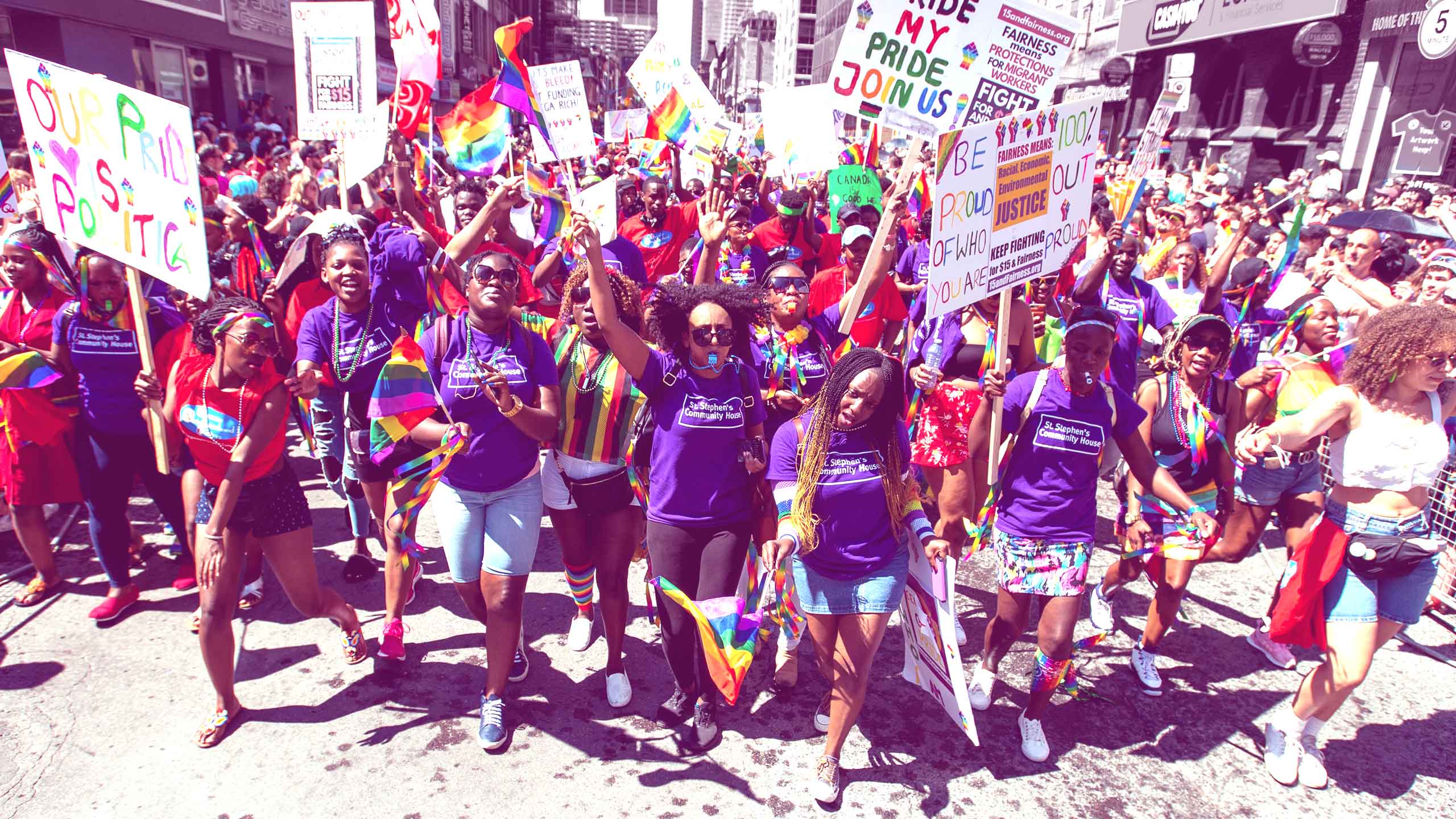Earlier this week, the global analytics firm Gallup released its latest update on the sexual and gender identities of Americans and it found that the number of lesbian, gay, bisexual or transgender adults in the country has risen to 5.6 percent, up from 4.5 percent in 2017. (The results are based on 15,000 interviews with Americans aged 18 and older conducted throughout 2020.)
Of those who fell into the LGBTQ2S+ category, bisexuals were the largest segment at 54.6 percent of the community, gay men at 24.5 percent, lesbians at 11.7 percent and trans people at 11.3 percent. (The “other” category makes up 3.3 percent.) The biggest news is that Gen Z should be renamed Gen Q (as our lesbian oracles have already prophesized): One in six people aged 18 to 23 are a member of the LGBTQ2S+ community.
The results were received with celebration by LGBTQ2S+ folks. But for all of the revelling, there remained some handwringing from the conspiracy-minded and bigoted corners of the gay internet, with dire warnings about the rise of bisexuals and the demise of lesbians.
Senior editor Erica Lenti and editorial director Rachel Giese break down the study and the reactions to it below.
Rachel: Erica, are you there? You haven’t disappeared? Based on some people’s social media posts, I was worried that there had been a sequel to The Leftovers in which all the lesbians vaporized! But before we go there, let’s talk about the survey. What was your initial reaction to the data?
Erica: I’m here, I’m queer, get used to it, Rachel. To be frank, I didn’t find the results all that surprising: As social acceptance of queer and trans folks grows and as legal fights are won, it makes sense that Americans would feel safer, prouder, and more comfortable to self-identify as “One of Us.” Since 2017, the last time Gallup collected this data, we’ve seen a growing number of LGBTQ2S+ Americans in positions of political power, greater equality and protections for queer and trans people in the workplace and a lot more meaningful representation of our communities in media. (And yes, that’s all happening despite the past four years of anti-queer and anti-trans Trump rhetoric—we’re a resilient bunch.) I imagine as time wears on, we’ll be seeing even more queer and trans folks finally feeling emboldened to wear the rainbow on their sleeves.
Rachel: Agreed: The fact that 2 percent of Boomers compared to 15.9 percent of Gen Z identify as LGBTQ2S+ doesn’t signify that we are suddenly getting queerer; rather that it is simply safer now to express who we are. When I look at the huge shift in these numbers, the takeaway isn’t that the kids are all “going through a phase,” as some have suggested. Instead, I think—with a great deal of sadness—about the enormous number of LGBTQ2S+ people in older generations who have been confined to the closet or forced into silence. I’m also reminded of the thousands and thousands of gay and bisexual men in their 40s, 50s, 60s and older who are not accounted for because they died during the AIDS crisis. The absent people in this survey tell as much of a story about our community as those who are present.
Speaking of those who are present: According to the poll, bisexuals are the biggest segment of our community, proudly representing more than half of us. That certainly tracks with what we’ve seen and heard from our audience, with the growing visibility and activism of bisexual people and with the popularity of our stories on bisexuality and bi communities. And yet, there remains a lot of ignorance of and disregard for bi folks.
Erica: I love that so many young people feel comfortable identifying as bisexual these days. I’m not old, but being in high school a decade ago, I recall encountering a lot of those stereotypes around bisexuality—that it’s an in-between stop before identifying as gay or lesbian or that it’s a phase—that I don’t think are as prominent for teens and young adults anymore. It’s so refreshing to watch a generation come along and say, “It’s cool to like people of different genders, and we’re going to support that and respect that.” That makes me so happy! Even if Glenn Greenwald and a bunch of the Twitterverse still want to erase bi identities!
The same goes for trans youth and millennials, who represent the majority of trans Americans. Again, I think this is a case of more rights, increased visibility and greater safety in coming out as trans or outside of the gender binary in a way that so many of our trans elders couldn’t. That, of course, doesn’t preclude the fact that trans and non-binary folks remain most at risk of homelessness, poverty, suicidality and mental health issues. But it does speak to a shifting sense of societal acceptance, of moving in the right direction.
And then there’s the supposed Case of the Disappearing Lesbians.
Rachel: I’m certain that’s the title of a lost Nancy Drew mystery (Nancy was a total lezzie, by the way). Unfortunately, the results have been taken up by some reactionaries as part of an ongoing anti-trans disinformation campaign to falsely and dangerously suggest that trans women and trans men are destroying lesbians and lesbian culture. In the case of the former, the argument falls within the typical TERF talking points: that trans women aren’t “real women” and therefore can’t be lesbians. Trans men, meanwhile, have been targeted as being responsible for “the disappearing butch lesbian.” (Another Nancy Drew mystery, featuring her tomboy pal George.) Last year, in a newsletter piece entitled “Where Have All the Lesbians Gone?” Katie Herzog suggested—based entirely on anecdotes from unidentified sources—that butch lesbians were being duped into transitioning and abandoning the lesbian community because of “social contagion.”
There are many reasons that these arguments are very, very bad: They’re discriminatory, they’re cruel, they’re utterly unfounded and they’re deliberately divisive. And as well-known homophobes like Barbara Kay have begun to spout the “disappearing lesbian” trope, they’re also disingenuous. Where were these defenders of lesbianism when we were fighting for civil rights and anti-discrimination protections?
And, guess what? According to the Gallup poll, lesbians aren’t disappearing at all. As BuzzFeed’s Shannon Keating pointed out, Gen Z has a higher proportion of self-identified lesbians than any other age cohort. It’s a les-aissance!
Erica: I personally enjoy the idea of a bunch of butch lesbians retreating to a beach resort, maybe hanging out on an Olivia Cruise, planning for world domination while a bunch of far-right kooks suspect they’ve been overtaken by some trans agenda. Imagine the possibilities!
But in all seriousness: It’s deeply concerning watching so many people—especially those outside of our communities—pitting lesbians against trans folks and weaponizing queer women’s identities as a means to be transphobic. (One particularly annoying sticking point for me is that trans and lesbian identities are not mutually exclusive. Trans and non-binary lesbians exist, y’all!) A majority of the tweets I encountered on my timeline came from straight cis men who probably wouldn’t care all that much about this supposed plight of lesbians should it not be an opportunity to knock trans folks down a peg.
Unfortunately, the release of this data is just the latest in news to be used and abused by anti-trans powers. Scrolling through the timeline today, I came across a video of a representative from Georgia plastering a sign that reads “There are TWO genders: Male and female. Trust the science!” in response to her neighbouring representative hanging a trans flag outside her door in honour of her trans daughter. (What science in particular we should be trusting, I don’t know.) But suggesting that progress, societal acceptance and legal gains for trans people are somehow an attack against lesbians and cis women is a bogus talking point—especially when, as you noted, Rachel, we look at all of those Gen Z girls and women proudly wearing the lesbian moniker.
Rachel: Millennial women, too: A couple years ago, we published a piece by Lauren Strapagiel about her process of embracing the lesbian label. Lauren beautifully articulated how lesbians can celebrate our history, community and culture without excluding or denigrating others. And as you crucially point out, Erica, our identities are not mutually exclusive; a lot of us represent more than one letter or shade in the LGBTQ2S+ rainbow. We have to resist the rhetoric that sets out to divide us, or make us suspicious of one another. As Lauren puts it, “If there is a threat to the existence of lesbians, it’s not trans folks (and certainly not trans lesbians), or sexual fluidity or relaxed binaries. It’s what it’s always been: homophobia and heteronormativity.”
We’ve witnessed how the movement for the rights and protections for gay men and lesbians has left behind trans and non-binary people. And in a year that has been devastating for all our community institutions—our bars, cafés, bookstores, community centres—we have an even greater need to come together.
Maybe I’m projecting my own dreams onto the Gallup poll results, but these figures make me feel optimistic. I hope that these growing numbers of openly queer and trans people signify an even stronger, more powerful and increasingly diverse community. And remember: These are only figures from the U.S. The past few years have seen more LGBTQ2S+ activism, movement building and visibility from all around the world.
Erica: I agree—and I’m not normally the sentimental type. But seeing these numbers grow, especially among youth, gives me the warm fuzzies. We’re watching queer and trans folks feel emboldened and ready to share who they are with the world, and that’s wonderful given all our communities have been through in decades past. It’s like watching history unfold gradually, statistic by statistic. Silly to think of data as inspiring, I know!
In the very least, we’ve solved a mystery here. The lesbians—and the bi and trans kids, and all of the other LGBTQ2S+ Americans encapsulated in this Gallup poll—are alright. Case closed.



 Why you can trust Xtra
Why you can trust Xtra


